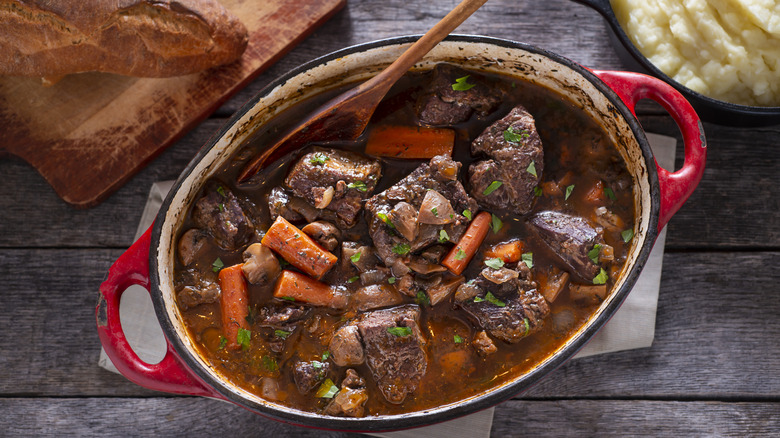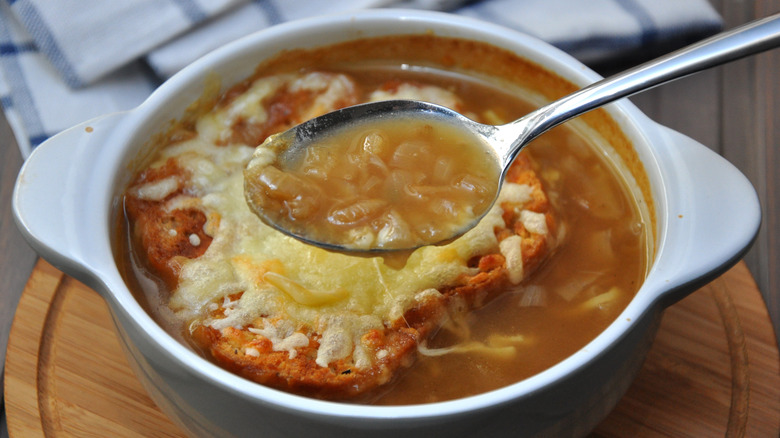The Fruity Liquor Ina Garten Uses To Boost Beef Stew
Cooking with alcohol is a great way to add extra depth of flavor and complexity to a number of dishes. From tenderizing meat when used as a marinade, to enriching a sauce to pour over the finished dish, different drinks can add all sorts of unique tastes and textures in the kitchen. And one of the most classic recipes has to be a beef stew — given an extra boost with a good glug of red wine.
It's no surprise that many famous chefs and TV food personalities love cooking with booze, too. Hearty red wine-braised short ribs, cooked with a full bottle of wine, is Ina Garten's favorite recipe she's ever written. And while that particular recipe also features Guinness for a rich, savory flavor, the Barefoot Contessa also likes to experiment when it comes to recipes involving alcohol. When making beef stew, for example, Garten boosts the dish with Cognac, a fruity French spirit.
A type of brandy made from grapes and aged in oak barrels, Cognac, which comes from the Cognac region in southwestern France, is a rich and highly aromatic liquor. And while it's a key ingredient in several cocktails, such as a punchy sazerac, it also adds layers of extra flavor when used in cooking.
Ina Garten adds Cognac for richness and balance
Yes, there is a difference between Cognac and brandy. While Cognac is a type of brandy, it is produced under stringent requirements and is a protected French appellation d'origine contrôlée (AOC). Cognac has to come from Ugni Blanc, Folle Blanc, or Colombard grapes from the geographically protected Cognac region. The resulting liquor is renowned for its fragrant fruitiness, with notes of spice, toasty oak, and vanilla. As Ina Garten explains, the flavorful spirit gives the sauce for her beef stew "an extra edge" (via Instagram).
While Cognac adds complex and refined flavors to dishes such as Garten's slow-cooked beef, it also has another benefit. As well as enhancing the deep, hearty flavors in the recipe, the alcohol also helps to cut through the richness, bringing balance and contrast.
But a little of the intense, strong-tasting spirit goes a long way in cooking, so add just a small amount to start with and taste as you go, so as not to overwhelm the other flavors. The Barefoot Contessa uses a quarter of a cup of Cognac along with a little red wine to deglaze the pan once she's browned the short ribs for her beef stew. She then simmers the mixture, which is further enriched by beef broth, more wine, and canned tomatoes. The rich, boozy liquid provides a hearty base for the meat to slowly cook in.
More ways to cook with Cognac for fruity French flavor
Cognac is a classic component of rich meaty stews, such as French-style slow-cooked boeuf bourguignon or coq au vin – where it elevates the overall flavor and balance. But it can also be used in a variety of other dishes, too, where it brings a flavorful French touch. Try deglazing the pan you've cooked pepper-crusted steaks in with Cognac and mixing it with heavy cream for a simple yet luxuriously silky sauce for steak au poivre. Or combine Cognac with chicken broth, white wine, cream, and Dijon mustard for an elegant sauce for chicken.
As well as stews and braised meats, Cognac also adds extra depth to soups, too. Try incorporating the aromatic spirit in French onion soup or lobster bisque to take them to the next level. Or try a splash in an earthy mushroom soup with heavy cream and herbs for a deeply fragrant bowl of comfort.
And it's not just savory recipes that benefit from a little Cognac; the spirit can also be used in sweet dishes, too. The spicy yet fruity flavors pair especially well with chocolate, in dishes such as a grown-up chocolate mousse or truffles. Or try adding a little to the sweetened whipped cream to accompany a pumpkin pie; the oak and vanilla notes complement the sweet and spicy dessert perfectly.



